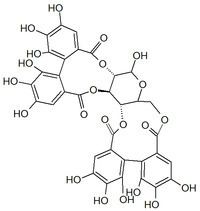Molar mass 784.54 g/mol | ||
 | ||
Pedunculagin is an ellagitannin. It is formed from casuarictin via the loss of a gallate group.
Contents
Natural occurrences
Pedunculagin is found in plants in orders in the clade Rosidae. It can be found the pericarp of pomegranates (Punica granatum), in the family Lythraceae, in the order Myrtales. It is also found in plants in the order Fagales such as walnuts (Juglans regia) in the family Juglandaceae, in Alnus sieboldiana and in the Manchurian alder (Alnus hirsuta var. microphylla), both species in the family Betulaceae and it is one of the main oak wood ellagitannins along with castalagin, vescalagin, grandinin and roburins A-E (genus Quercus, in the family Fagaceae). It is also found in the Indian gooseberry (Phyllanthus emblica), a plant in the family Phyllanthaceae, in the order Malpighiales.
Galloyl pedunculagin can be found in Platycarya strobilacea.
Health effect
It is a highly active carbonic anhydrase inhibitor.
Chemistry
It is an isomer of terflavin B. It can be synthetized.
